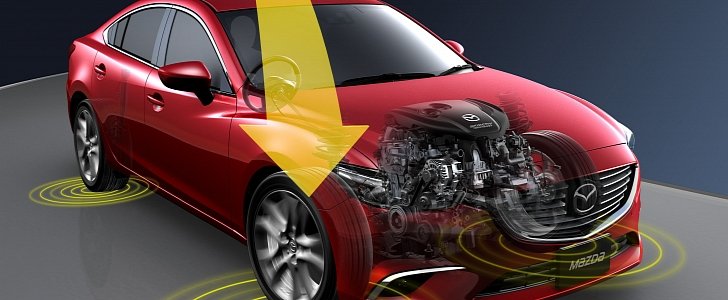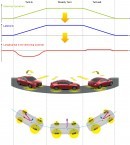Mazda has launched the 2017 Mazda3/Axela in Japan, and it comes with the G-Vectoring Control system.
We are writing about Mazda’s first torque vectoring solution, which has been designed to provide a higher level of comfort for the occupants of its models.
Unlike other torque vectoring systems, the G-Vectoring Control works through the engine by limiting torque developed at certain points, especially during specific steering inputs, which are pre-programmed, so they improve traction.
Mazda explains that the system will bring more confidence to the driver by reducing steering effort, along with following the driver’s actions with more fidelity. The level of comfort perceived by the driver can be increased by decreasing the need for unconscious steering corrections, and also by lowering fatigue over long distances.
For both drivers and passengers, the system claims to reduce torso sway, the phenomenon that refers to a human body moving in a seat while the vehicle transitions its weight from one side to the other.
Mazda has explained that the system works best on wet or snowy roads, especially on rough surfaces. However, it works at almost all operating speeds without affecting performance, handling, or dynamic behavior.
Unlike other torque vectoring systems, no braking force is applied to the wheels of the vehicle. Since the system is only a software element, it can be deactivated when desired, and it does not bring any weight penalties to the car.
Naturally, the system only cuts the torque delivered to the wheels of the vehicle by a subtle margin. The automaker has explained that just a minor reduction is sufficient to improve handling without affecting performance.
Customers of the 2017 Mazda3 with G-Vectoring Control will be able to drive with the system deactivated, even if the car features it. Mazda has already confirmed it will launch the system in Europe later this year. A launch in the US market is also scheduled, where it will be launched on the Mazda6 before the end of this year.
Unlike other torque vectoring systems, the G-Vectoring Control works through the engine by limiting torque developed at certain points, especially during specific steering inputs, which are pre-programmed, so they improve traction.
Mazda explains that the system will bring more confidence to the driver by reducing steering effort, along with following the driver’s actions with more fidelity. The level of comfort perceived by the driver can be increased by decreasing the need for unconscious steering corrections, and also by lowering fatigue over long distances.
For both drivers and passengers, the system claims to reduce torso sway, the phenomenon that refers to a human body moving in a seat while the vehicle transitions its weight from one side to the other.
Mazda has explained that the system works best on wet or snowy roads, especially on rough surfaces. However, it works at almost all operating speeds without affecting performance, handling, or dynamic behavior.
Unlike other torque vectoring systems, no braking force is applied to the wheels of the vehicle. Since the system is only a software element, it can be deactivated when desired, and it does not bring any weight penalties to the car.
Naturally, the system only cuts the torque delivered to the wheels of the vehicle by a subtle margin. The automaker has explained that just a minor reduction is sufficient to improve handling without affecting performance.
Customers of the 2017 Mazda3 with G-Vectoring Control will be able to drive with the system deactivated, even if the car features it. Mazda has already confirmed it will launch the system in Europe later this year. A launch in the US market is also scheduled, where it will be launched on the Mazda6 before the end of this year.











